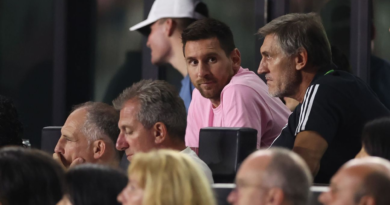Rose's NBA legacy — and his unique case for the Hall of Fame
After 16 years in the NBA, former MVP point guard Derrick Rose is retiring from the league.
The No. 1 pick in the 2008 NBA draft and Chicago native made his mark for seven years with his hometown team before spending the next nine jumping between the New York Knicks, Cleveland Cavaliers, Minnesota Timberwolves, Detroit Pistons and Memphis Grizzlies.
Rose’s meteoric rise as one of the league’s most exciting players was thwarted by injuries: most notably, his ACL tear during the first round of the 2012 playoffs which was followed by a plethora of lower leg issues.
NBA insiders Chris Herring, Jamal Collier and Kevin Pelton break down the three-time All-Star’s career, including the legacy he leaves in Chicago and his unique case for the Naismith Basketball Hall of Fame.
Rose’s brief — but elite — prime was electric
In 2010, almost 14 years ago to the day, a 21-year-old Rose stood before a gaggle of Chicago reporters laying out his expectation for his third NBA season.
“It’s high,” he said with a straight face. “The way I look at it within myself, why can’t I be the MVP of the league? Why can’t I be the best player in the league? Why can’t I do that? I work hard.”
It was an audacious comment. Yes, Rose won Rookie of the Year in 2009 and was one of the sport’s breakout young stars. But he’d been an All-Star just once, selected for the game just seven months earlier. On a team scale, Chicago was a .500 club the season before — something else that generally makes an MVP bid a steeper climb.
But by the end of the 2010-11 campaign, Rose looked like a prophet. The Bulls, who finished with an NBA best 62-20 mark, were buoyed in part by new coach Tom Thibodeau. But no one was more responsible for their improvement than the electrifying Rose, who, in leading his hometown Bulls at age 22, became the youngest MVP in league history.
Between Chicago being among the league’s elite and Rose reaching meteoric heights at such an early stage — the Bulls also reached the conference finals that season — it became natural to wonder what his progression might look like — both for him and his team.
At that point, it seemed possible, if not likely, that he’d be mentioned alongside fellow Chicago star Michael Jordan or LeBron James — Rose’s Eastern Conference adversary for a few years — in the basketball history books.
But that was before the repeated knee injuries — a torn ACL in his left knee in 2012, a pair of tears in the right knee’s meniscus in 2013 and 2015 and a tear to his left meniscus in 2017 — sapped Rose of his trademark explosiveness and altered the trajectory of his career.
Like Grant Hill, who battled serious injuries in his prime for years before getting healthy and having a solid finish to his Hall of Fame career, Rose did have flashes toward the end of his NBA run. He had a highly emotional 50-point game with Minnesota in 2018 and was a key contributor to the Knicks’ surprising playoff run in 2021, finishing third in Sixth Man of the Year voting.
It wasn’t the years of greatness that someone like James will be remembered for. But for a few years and a handful of moments toward the end of his career, Rose’s uncanny athleticism and playmaking made fans’ jaws drop. It was a highly unusual basketball journey, with massive highs and devastating lows. But it’s one that everyone who saw it will remember.
— Chris Herring
The legacy Rose leaves in Chicago
The Bulls landing the No. 1 overall pick in the 2008 draft despite having just a 1.7% chance was a rare stroke of good luck for a franchise devoid of success since Jordan’s Last Dance.
The fact that one of the top prospects available was from Chicago made the decision clear. And his arrival would dramatically alter the direction of the franchise.
Rose’s legacy in Chicago will live on not just for his accomplishments on the Bulls. He grew up in poverty in the city’s Englewood neighborhood and won back-to-back state championships in high school. Five years later, he carried the Bulls to their only conference finals in the past 25 years.
From Rookie of the Year to All-Star to youngest MVP in league history, the first three years of Rose’s career were an unmatched force, lifting Chicago to its best seasons since the Jordan era. His 36-point playoff debut in 2009 was electric, and the Bulls took the defending champion Boston Celtics to seven games in a thrilling first-round series.
His poster dunk of Goran Dragic in 2010 was invigorating, a display of the kind of fearlessness that made Chicago fall in love with him. By 2011, the Bulls were contenders once again. Rose turned to his mother when signing a max contract extension that year and said, “Mom, we finally made it.”
1:00
Stephen A. reflects on Derrick Rose’s NBA legacy
Stephen A. Smith looks back on Derrick Rose’s most memorable moments during his 16-year NBA career.
The injuries that followed derailed the ending of his story in Chicago and remains one of the most painful memories in city or team history. Rose sat out the entire 2012-13 season with a torn ACL and played just 10 games the following season as fans anticipated and questioned his return to the court every step of the way. When he was able to play, it was clear the injuries had altered his career. He was never able to maintain the still high expectations set in Chicago.
Some of Rose’s key teammates from that era, Joakim Noah and Luol Deng, to this day will emphasize their belief that Chicago would have eventually won a championship had injuries not betrayed Rose. It makes those Bulls teams one of the great “what-ifs” in NBA history.
As Rose’s career was winding down, and he bounced around the league from team-to-team, fans in Chicago still cheered him whenever he arrived at the United Center as a visitor. It was as if they were still clamoring for one last chance at a reunion and a happy hometown ending.
– Jamal Collier
Rose’s unique case for the Hall of Fame
Rose might be the most interesting case the Naismith Memorial Basketball Hall of Fame has ever seen. For decades, it’s been a truism that every NBA MVP would make the Hall of Fame. Yet Rose’s injury-shortened peak makes his candidacy more complicated.
Among the 36 players to win MVP, Rose’s three All-Star appearances rank ahead of only the late Bill Walton (two), the other winner to see his prime years ruined by injury. Whereas Walton played just a handful games between the navicular fracture that interrupted his MVP campaign and age 30, Rose was able to return for a relatively full career but was never an All-Star again.
Unlike Walton, who led the Portland Trail Blazers to the only title in franchise history the year before his injury, Rose didn’t get to enjoy playoff success on the biggest stage. He averaged 23.4 points and 6.6 assists per game in the 2011 East finals at age 22, but shot just 35% as the Miami Heat beat the Bulls. A year later, Rose was injured in the first playoff game for Chicago, which had won a league-high 50 games during the lockout-shortened season but was upset by the No. 8 seed Philadelphia 76ers without him.
In that regard, my championships added model sees Spencer Haywood as the best comparison for Rose’s career. MVP of the ABA as a 20-year-old rookie, Haywood made All-NBA four times after successfully challenging the league’s age limit and jumping to the Seattle SuperSonics. However, Haywood’s career was never the same after a knee injury at age 25 and his move to the Knicks.
Haywood played slightly longer than Rose, and totaled more than 15,000 career points (surpassing 17,000, including his ABA season), as compared to Rose finishing with 12,573. Still, he had to wait until 2015 — 32 years after retirement — to be enshrined in the Hall of Fame, following several close calls.
As the Hall of Fame casts a wider net under executive director Jerry Colangelo, I suspect Rose will eventually make it as well. Still, Rose’s untimely injury makes his Hall future less certain than any MVP winner in league history.
– Kevin Pelton



